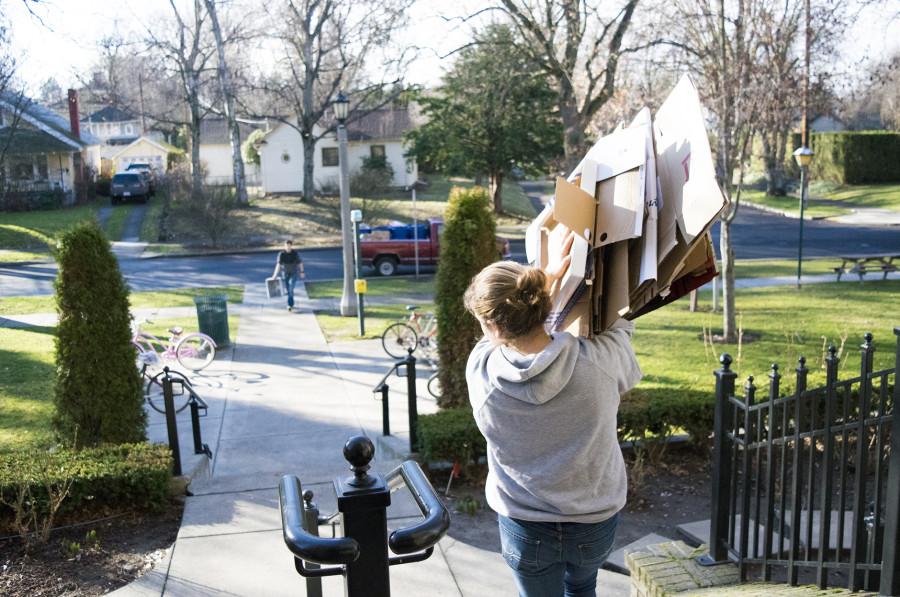Many of the exhibits on campus fly under the radar of many students, ranking as features of the college that people have heard of but not actually taken the time to see. Between the Penrose Library archives, the Maxey Museum holdings and many others, Whitman has much to offer in exhibits. That they go unnoticed is surprising––especially when there’s an entire room in the basement of the library devoted to Napoleon.
The Stuart Napoleon Room was opened in 1974 and is home to roughly 35 artifacts related to the life of Napoleon Bonaparte. All of the artifacts as well as the funding for the room were donated by Elbridge H. Stuart, husband of alumna Evelyn Clark Stuart ’28. The room is decorated by elaborate curtains, chairs and furniture that are from Napoleon’s era. Only three objects within the room are replicas of the time period; the rest are from the 19th century. The centerpiece of the room is Napoleon’s surgeon’s desk.
“When you look at the room you’re not just looking at the text that people wrote about the past or wrote during the past; you’re also looking at what people were wearing and what the furniture was like and what the decorations were like. It says a lot about the kinds of things they were privileging or emphasizing during the time,” said Melissa Salrin, archivist and special collections librarian.
While the Stuart Room seems inaccessible, it is still available for any student or community member who wants to explore Napoleon artifacts. The archivists are more than willing to open up the room to visitors. The only reason that the room is not permanently open is because artifacts must be kept at a certain temperature and humidity to be preserved, and constant supervision of the room is not a feasible option with the limited archivist staff.
The Stuart Room is not the only impressive display the library archives have to offer. A library committee in connection with the archives has been formed this year to create two glass showcases that are placed at the entrance of the library. The two exhibits showcased now are “The Ages of Literary Magazines at Whitman College” by senior Bo Erickson, which shows the transformation of the Whitman magazine blue moon over the years, and “This is Sunday the Day of Rest, but No Rest for Us: The Henry Canfield Civil War Letters” by senior Kate Kunkel-Patterson, which contains letters from the Civil War era that were available in the archives. The exhibits are new experiments this year to showcase the varied talents and interests of Whitman students.
“We have not concretely defined what [the exhibits] are because we want them to be open,” said Salrin. “We are definitely open to students contacting us with ideas about things they potentially want to show off, because we want to showcase the kinds of amazing work that students are doing.”

Also featured in the library as well as in Maxey Hall is the Maxey Museum, which is really an assortment of ten exhibits. Beginning its collection in 1899, the Maxey Museum archives are home to approximately 3,500 artifacts that have been donated by residents of the community.

“It’s a hugely diverse collection; we have an unusual assortment of artifacts,” said alumna Brynne Haug ’12, collections manager of the Maxey Museum. “It takes a lot of research experience and practice to figure out what artifacts are.”
Currently on display in the Maxey Museum is an assortment of hats from different cultures and time periods. In another exhibit in Maxey there is a description of different rocks and their origins within Palestine and Egypt.

“Part of [the exhibit] is education; to arrange artifacts in a way that makes people think about ideas or history in a way that they have not thought about before,” said Haug. “It’s interesting to put those artifacts there and think about what was necessary and why.”
Students who usually have an affinity for history or anthropology join the museum each year to sort through the hodgepodge of items collected over the years and form a cohesive theme for an exhibit.
Haug has worked in the Maxey Museum for four years. She was appointed this year as the museum’s first collections manager. Along with creating written instructions for upkeep of artifacts, Haug has new plans for the museum.

“When the museum was founded they had a goal and a plan for it and we’re just sort of coming back to that,” said Haug. “My job is to professionalize the way the museum is run and to get the word out into the community that it exists, which is hard because it’s so spread out, but certainly possible because the museum has a lot to offer Whitman.”
Whitman has a wealth of resources, from written records to historical artifacts. These resources are always available to be viewed and accessed, but it’s a matter of personal imperative to get out there and check them out.
“People need to see that we have a lot of amazing special collections at Whitman,” said Salrin. “These are the raw materials for intellectual pursuits and creativity.”









